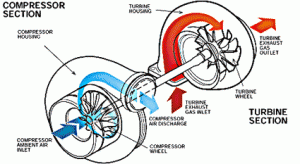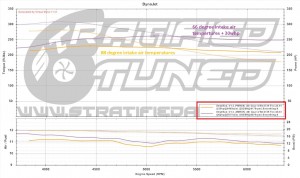Since we work with a lot of turbocharged vehicles, we often get customers that notice a difference in the performance of their vehicle on hot summer days in contrast to cool autumn evenings. The performance hit from the hot summer air is dramatic on any turbocharged vehicle and here is why.
A turbocharger is a compressor. It pulls in fresh air and compresses it to a specific pressure (boost pressure) therefore pushing more oxygen molecules inside the combustion chambers of the motor. With more oxygen available to burn, the engine makes more power.
Temperature plays a big role here because as the air temperature is increased, its density decreases (PV = nRT for you science buffs). Therefore, if the temperature of the ambient air is increased, the turbocharger now must do more work (spin faster) in order to provide the engine with the same amount of oxygen. As temperatures continue to increase, the turbocharger can no longer increase its speed efficiently and therefore can no longer provide the engine with the same amount of oxygen. This results in a loss of power.
There’s another fact to consider. As the turbocharger is compressing the hot intake air, it is naturally increasing its temperature (again, PV = nRT). Generally the intercooler cools this charged air because hot charged air leads to engine knock. The hot ambient air temperatures compound here because the intercooler is also exposed to these hot outside air. The end results is that charge air temperatures (boosted air temps) rise dramatically and timing must be reduced to prevent engine knock. This also causes a drop in power. To get an idea of how much of a difference this makes, check out the dyno plot below. This is the same MazdaSpeed6 car with the same tune, same modifications etc. The two plots are taken on the same day and you can clearly see how much area under the power curve the car loses at all engine speeds. The difference in intake air temperatures is only 20 degrees F and that costs this vehicle 30 peak wheel horsepower.
Since we can’t change mother nature (and summer is a wonderful time to go for a drive), here are some useful tips for reducing the effects of hot air temperatures on your turbocharged vehicle:
To reduce the intake air temperatures and promote airflow/available oxygen:
– Use a cold air intake. Try and feed the turbo air that is as cool as possible and keep intake piping and the fresh air source away from hot areas such as the exhaust manifold.
– Use a larger intake. A turbo will have an easier time “sucking” the fresh air through a larger intake. The sky’s the limit here, go as large as your vehicle is able to fit.
– Use a clean, well flowing air filter.
– Install a larger turbocharger. Larger turbochargers will flow more air under all conditions.
To reduce charged air temperatures and knock during hot weather:
– Install an efficient intercooler. This will reduce charged air temperatures and lower the possibility for knock.
– Use a water or methanol injection system. This can be used to cool the charged air (after the turbo) or the intake air (pre-turbo).
– Run high octane gasoline during the summer to lower the possibility for knock or an alcohol blended fuel (E85).
– Run a colder spark plug to remove more heat from the combustion chamber.
It is also important to have a tune that is setup for all weather conditions and temperatures. This will ensure that you’re always at peak efficiency for your given setup. If you have any further questions, please Contact Us.
Happy Summer Drives!
The Stratified Team


